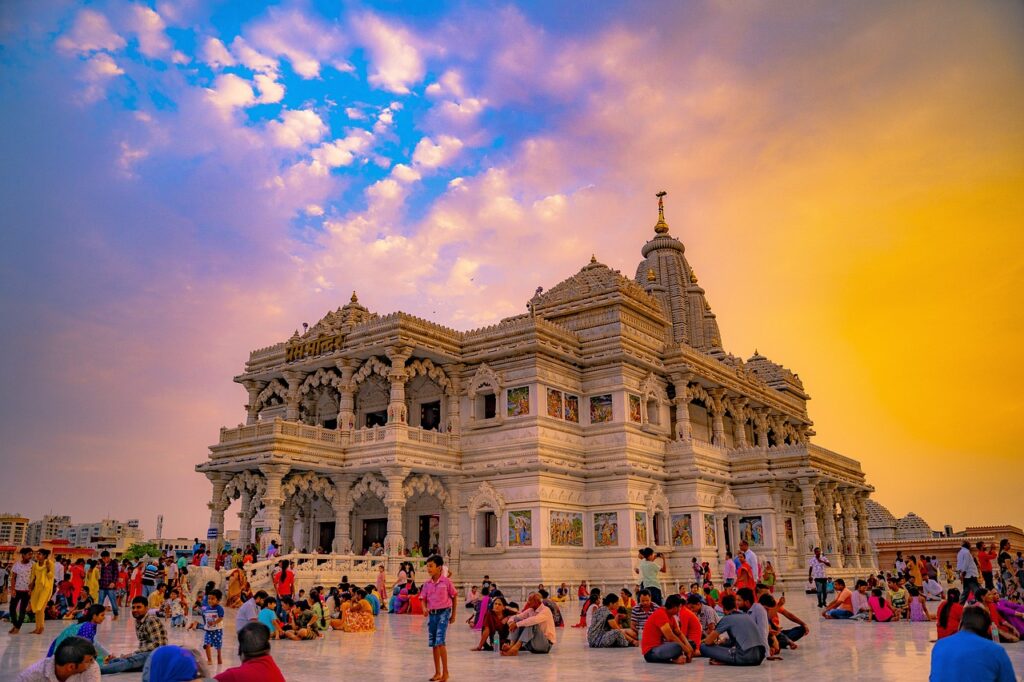
In the mystical land of Vrindavan, where the sweet melodies of devotion blend with the fragrant blooms of spirituality, lies a haven of divine transcendence. Nestled on the banks of the revered Yamuna River, this sacred city beckons pilgrims and seekers from far and wide, offering a gateway to eternal bliss. Vrindavan, a place where time surrenders to the fervent chants and dance of love, is home to a myriad of temples, each exuding an aura of sanctity and serenity. Join us on an enchanting journey through this hallowed realm as we explore some of Vrindavan’s most revered and captivating temples, where the earthly and the ethereal merge in a harmonious symphony of devotion and reverence. Embark upon this spiritual odyssey, and allow the divine essence of Vrindavan’s temples to ignite the depths of your soul, leaving an indelible imprint of transcendence within your heart.
#1 Banke Bihari Temple
Nestled amidst the bustling streets of Vrindavan lies the enchanting Banke Bihari Temple, a revered abode that emanates a divine aura. As I approached its grand entrance, a sense of awe washed over me, for within these walls, centuries of devotion and spirituality have found their home. Stepping inside, I was immediately captivated by the temple’s architectural splendor. Intricate carvings adorned every inch of the walls, depicting scenes from ancient scriptures and tales of divine love. Vibrant hues danced across the temple, as if breathing life into the sacred space. The air was thick with the scent of incense, carrying prayers and aspirations heavenward. In the heart of the temple, my gaze fell upon Lord Banke Bihari, the beloved deity who draws countless devotees from far and wide. Adorned with resplendent jewels and adorned with fragrant flowers, the deity stood in a tribhanga pose—gracefully curved at the neck, waist, and knees. The sight was simply mesmerizing, evoking a profound sense of peace and reverence.
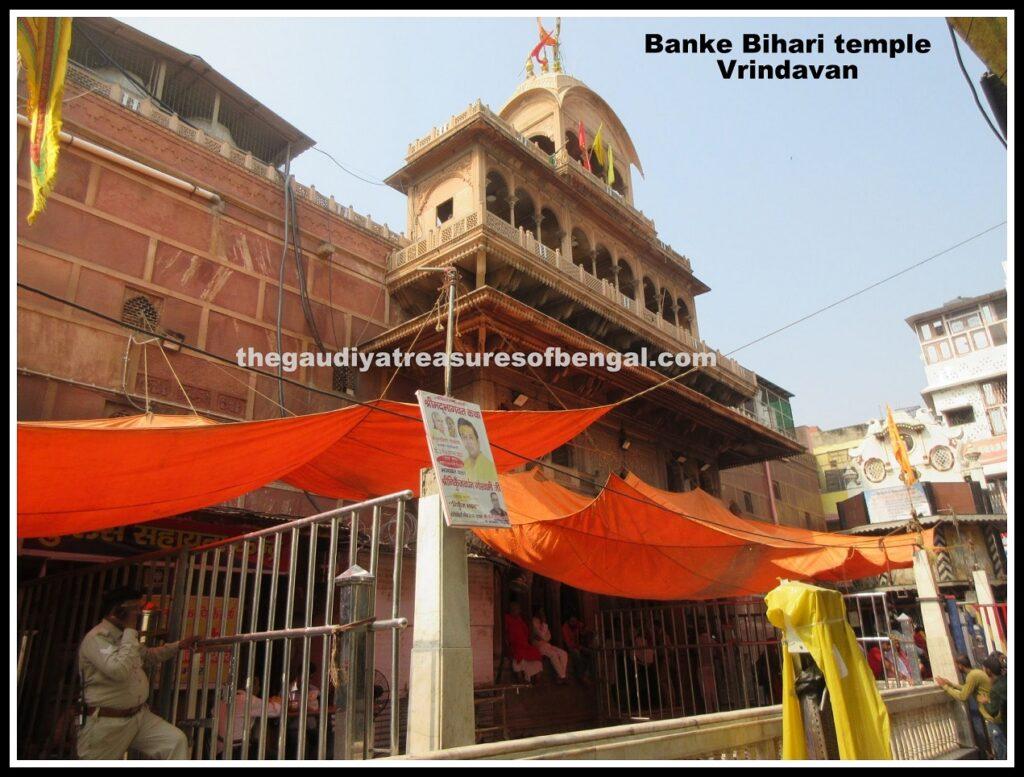
What set the Banke Bihari Temple apart from others was its unique tradition. Instead of ringing bells, the temple resounded with the rhythmic clapping of devotees. With each clap, they expressed their deep love and devotion, creating an atmosphere alive with spiritual energy and fervor. It was a vibrant symphony of devotion, a celebration of the eternal bond between the divine and the devotee.
The Banke Bihari Temple carries with it a rich history steeped in devotion. It is said that the deity was revealed to the saintly Swami Haridas Ji, who fervently sought a form that his disciples could behold. Legend has it that Lord Krishna and Radharani merged into a single deity, forever capturing the essence of their eternal love within the temple’s sacred confines.
Visiting the Banke Bihari Temple is an invitation to transcend the mundane and embark on a spiritual journey. It is a place where mortal beings connect with the divine, where hearts are touched, and souls are uplifted. The temple stands as a testament to the enduring power of devotion, drawing pilgrims and seekers alike, all seeking solace and spiritual connection. In the embrace of the Banke Bihari Temple, time seems to stand still. It is a sanctuary where one can immerse themselves in the divine presence, offering prayers, and finding solace in the divine grace that permeates every corner. Whether you are a seeker on a quest for enlightenment or a humble devotee seeking solace, the Banke Bihari Temple beckons you to experience the profound beauty of devotion and the eternal love between the divine and the devotee.
Location: Goda Vihar, Vrindavan, Uttar Pradesh 281121
#2 Iskcon Vrindavan Temple : Sri Krishna Balaram Mandir
Iskcon Vrindavan, also known as the Krishna Balarama Temple, is a magnificent spiritual haven where the rich cultural heritage of India intertwines with devotion. Located in the picturesque town of Vrindavan, the temple exudes a divine atmosphere, offering peace, serenity, and a deeper understanding of the timeless wisdom of the Bhagavad Gita and Srimad Bhagavatam. Founded by A.C. Bhaktivedanta Swami Srila Prabhupada, Iskcon Vrindavan stands as a symbol of spiritual and cultural heritage.
The temple houses the splendid deities Sri Sri Krishna Balarama, Sri Sri Radha Shyamsundar, and Sri Sri Gaur Nitai. Their exquisite beauty and intricate craftsmanship leave visitors awestruck. The main temple hall resonates with 24-hour kirtan, enchanting chants that create a mystical charm and evoke divine ecstasy.
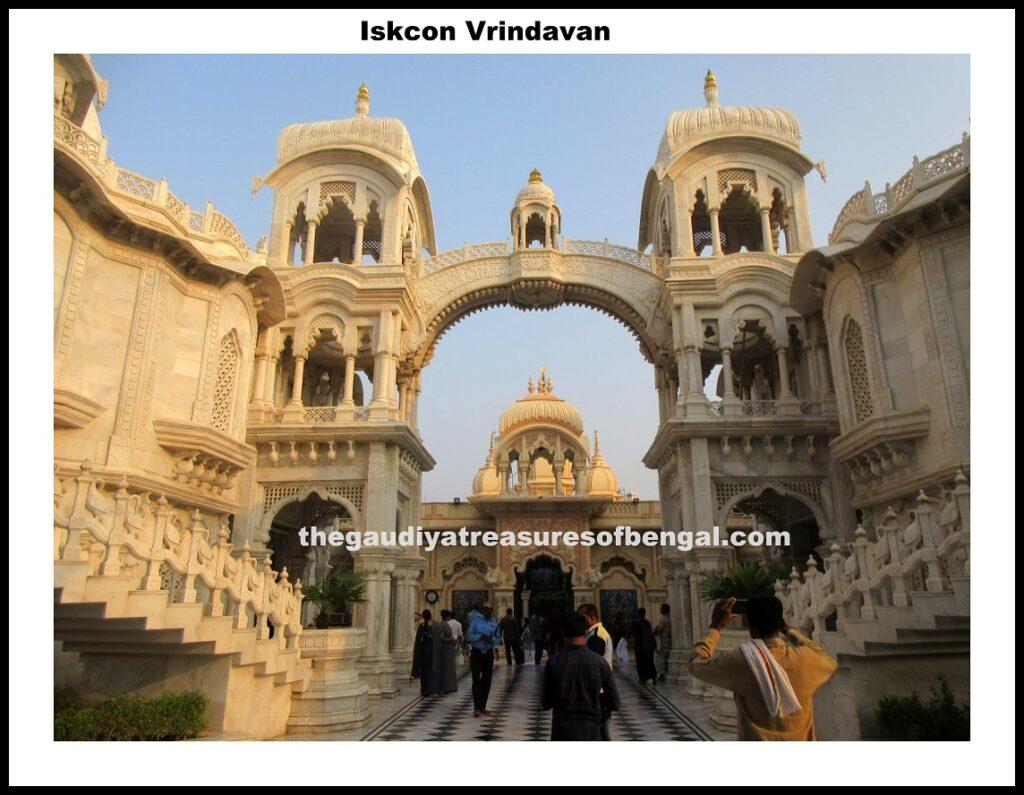
Sri Krishna Balarama Mandir is rooted in the sacred land where Lord Krishna and Balarama frolicked with their friends. The temple’s construction was personally overseen by Srila Prabhupada, ensuring perfection in every detail. The arrival of the deities brought about a magical transformation, captivating devotees with the divine atmosphere. Iskcon Vrindavan extends beyond being a temple; it serves as a preaching powerhouse with various departments catering to the needs of the community. The temple complex boasts architectural marvels such as Srila Prabhupada’s samadhi and the palace of Krishna Balaram, exuding a sense of joy and ecstasy.
In summary, Iskcon Vrindavan is a divine abode that blends spirituality, devotion, and cultural heritage. It offers a captivating experience through its mesmerizing deities, enchanting chants, and architectural wonders. A visit to this temple is a journey that brings peace, enlightenment, and a connection with the eternal love of Lord Krishna and his devotees.
Location: Bhaktivedanta Swami Marg, Raman Reiti, Vrindavan, Uttar Pradesh 281121
#3 Prem Mandir
Prem Mandir, known as the Temple of Divine Love, is a magnificent masterpiece located in Vrindavan. Spanning 55 acres, this majestic temple is a popular tourist attraction renowned for its beautiful architecture and stunning landscapes. Built-in 2012, it is dedicated to the worship of Lord Radha Krishna and Sri Sita Ram.
The temple features two floors, with the lower level housing the deities of Sri Radha and Krishna, and the upper level adorned with the deities of Sri Sita Rama. Its massive white structure against the backdrop of blue skies is truly captivating. The temple’s name, “Prem,” meaning love, beautifully signifies the eternal love between Radha and Krishna.
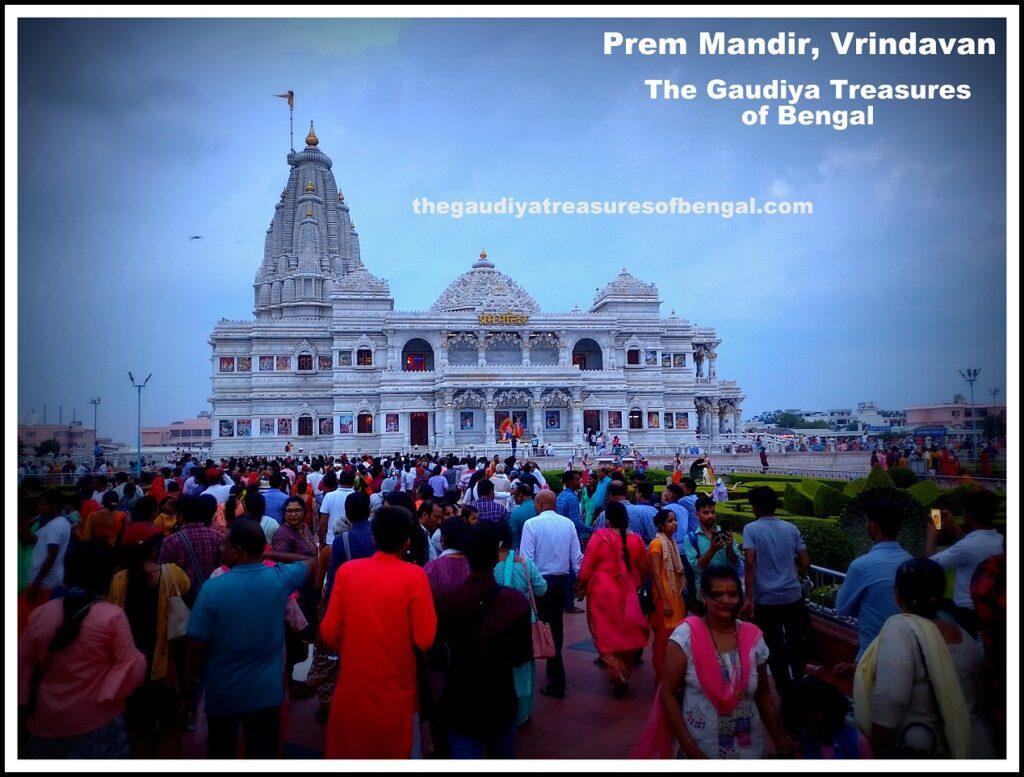
Prem Mandir showcases meticulous Italian marble construction with 94 crafted pillars, each carrying symbolic meanings. The outer walls display paragraphs written by Kripaluji Maharaj, while the interior is vibrant and colorful. The temple’s exterior is surrounded by exquisite gardens and landscapes, creating a mesmerizing setting.
Visiting Prem Mandir is a tranquil experience that leaves one feeling calm and peaceful. The temple illuminates in the evening with colorful lights, creating a breathtaking sight. The musical water show, held at 6 PM, presents captivating visuals of Krishna’s divine pastimes projected on a water foundation.
Inside the temple, beautifully crafted tableaus depict Krishna’s various pastimes, such as the Vrindavan Lila and Govardhan Parvat Lila. The meticulously maintained gardens add to the temple’s grandeur and royal ambiance. The white marble interiors, intricate designs, and engravings showcase the temple’s architectural brilliance.
Prem Mandir is a divine destination that leaves visitors awestruck with its grandeur, architectural beauty, and serene atmosphere. It stands as a testament to the love between Radha and Krishna and is a precious gift to Vrindavan by Sri Kripalu ji Maharaj, cherished by the locals and admired by visitors worldwide.
Location: Chhatikara, Road, Raman Reti, Vrindavan, Uttar Pradesh 281121
#4 Radha Raman Temple
The Radha Raman Temple in Vrindavan is a renowned and awe-inspiring temple that attracts countless devotees and tourists. Established by Gopal Bhatta Goswami, one of the revered Goswamis of Vrindavan, the temple is dedicated to Radha Raman ji (Krishna), a self-manifested form of the divine. The temple’s grandeur is evident in its intricate carvings and vibrant colors, creating a breathtaking sight. Inside, the temple exudes a palpable energy as devotees chant hymns and prayers, accompanied by the melodious sound of bells and cymbals.

Radha Raman ji, the deity enshrined in the temple, emerged from a Saligram Shila over 500 years ago. The temple follows the highest standards of worship in Vrindavan and is considered a priceless heritage site. The cooking fire in its kitchen has been burning continuously for over 460 years, and the temple’s cooking practices have remained unchanged since its establishment. This authenticity adds to the spiritual practices observed in the temple.
Adjacent to the appearance of Radha Raman ji is the samadhi of Gopal Bhatta Goswami, emphasizing his significant role in founding the temple. Gopala Bhatta’s devotion and spiritual legacy are honored at this sacred site. The temple also houses other revered Shaligram-shilas worshiped by Gopala Bhatta Goswami.
The appearance of Radha Raman ji is associated with Lord Chaitanya Mahaprabhu’s interactions with Gopala Bhatta Goswami. Lord Chaitanya’s guidance led Gopala Bhatta to Vrindavan, and his deep devotion and prayers resulted in the manifestation of the deity. This divine revelation transformed one of the Shaligram-shilas into the beautiful deity of Sri Radha Raman.
Location: Panchayat Mandir Shri Radharaman ji Maharaj, Vrindavan, Uttar Pradesh 281121
#5 Radha Govinda temple
Radha Govinda Temple in Vrindavan is an awe-inspiring place of worship known for its exquisite deity of Govinda Deva. According to legends, the deity was intricately carved by Vajranabha, the great grandson of Krishna, under the guidance of Uttara. The deity bears an uncanny resemblance to Lord Krishna’s beautiful face. The temple holds great significance for devotees, as it is believed that catching a glimpse of three deities – Sri Madana-mohana, Sri Gopinatha, and Sri Govinda Deva – in a single day before sunset grants divine blessings equivalent to seeing Lord Krishna Himself.

The temple was constructed by Maharaja Man Singh, a devoted follower of Lord Krishna, around 1590 AD. It was a grand seven-story structure with a magnificent marble, silver, and gold altar. However, during the rule of Aurangzeb in 1670, the temple was pillaged and reduced to only three stories. Despite this, the temple remains a remarkable architectural masterpiece, adorned with a sculptured lotus flower on the ceiling.
The temple’s significance is also connected to the discovery of the Govinda deity by Srila Rupa Gosvami. After an extensive search, Rupa Gosvami was guided by Lord Krishna in disguise to a hillock where a cow poured her milk into a hole. Excavating the hole, they discovered the awe-inspiring deity of Lord Govinda, evoking immense ecstasy and divine vibrations.
Another deity worshiped in the temple is Radha Rani, whose deity was originally located in Vrindavan and later brought to Vrindavan by King Purushottam of Orissa. The temple also houses the deity of Lord Chaitanya, known as Gaura-Govinda, gifted by Lord Chaitanya Himself to Sri Kashishwar Pandita.
The central figures of worship in the temple are Govinda jiu, Lord Chaitanya, and Lord Nityananda. Adorned with shimmering garments and ornate jewelry, these deities exude a divine aura, and devotees offer their heartfelt prayers and seek blessings in their presence.
The temple is situated in YogaPith, near Gopinath Bagh, in the holy city of Vrindavan. Its serene location and proximity to the revered Rangaji Temple make it a perfect destination for devotees seeking spiritual bliss and immersion in devotion. Although the original deities are now in Jaipur, the Pratibhu deities in the Radha Govinda Temple hold the same spiritual significance and blessing potential for devotees who come to seek the Lord’s darshan.
Location : Vrindavan khadar, Raman Reiti, Vrindavan, Uttar Pradesh 281121
#6 Radha Madan Mohan Temple
The Radha Madan Mohan Temple in Vrindavan is a renowned religious site with a fascinating history. Situated on a small hillock known as Sri Dwadashaditya Tila, the temple holds a significant tale from Lord Krishna’s time on Earth. After Krishna’s intense battle with the venomous serpent Kaliya in the river Yamuna, he climbed the hillock to warm himself in the sun. To provide warmth, 12 suns appeared in the sky and shone upon the hill. This hillock was named Sri Dwadashaditya Tila, and the spot where Krishna’s perspiration collected became known as Praskandan ghat.
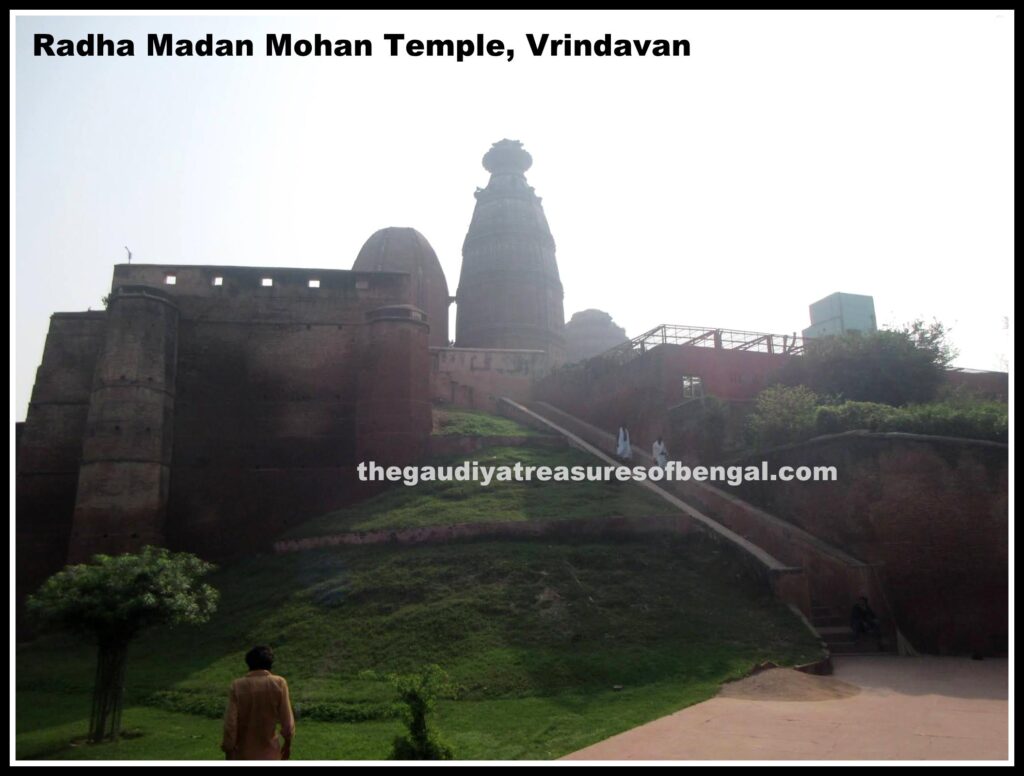
The Radha Madan Mohan Temple was built in 1580 by Ram Das Kapur under the guidance of Sanatana Goswami, who was sent to Vrindavan by Chaitanya Mahaprabhu to rediscover Krishna’s pastime sites. The temple is dedicated to Madanmohan, also known as the “enchanter of Cupid,” along with Radharani and Lalita Sakhi.
The original deity of Madan Mohan was lost for several years until it was discovered by Advaita Acharya at the base of an old banyan tree. The deity had been under the care of a brahmana named Purusottama Chaube. Sanatana Goswami corrected the brahmana’s improper deity worship and taught him the proper ways. However, Madan Mohan expressed his desire to be treated as one of the brahmana’s children and not subjected to strict rules. Eventually, Madan Mohan appeared in a dream to both Sanatana and the brahmana, instructing them to hand over the deities to Sanatana.
Sanatana, who lived on dry chapatis due to his poverty, initially hesitated to take the deities. But Krishna assured him in a dream that He would accept whatever Sanatana could offer. The deity of Madan Mohan became content with the dry bread balls offered by Sanatana. Later, with the help of a merchant whose boat was saved by Madan Mohan’s intervention, a temple was built for Madan Mohan in Vrindavan.
The temple houses the deity of Madan Mohan along with Radharani and Lalita, and it is considered one of the symbols of the area. The deities were relocated to Jaipur in 1670 due to attacks by Aurangzeb’s soldiers, but replicas now reside in the New Madan Mohan temple. The temple represents the progression of devotion from establishing a relationship with Madan-Mohan, dedicating oneself to Govinda Deva, and attaining the pinnacle of devotion through Gopinath.
Near the temple, visitors can also find the bhajan Kutir of Sanatana Goswami, his samadhi, the samadhis of Tapan Mishra and Chandrasekhara Pushpa, and the Grantha Samadhi housing sacred books written by the six Goswamis.
The Madan Mohan Temple is easily accessible by cab or auto-rickshaw from the Vrindavan Railway Station, which is approximately 1 km away.
#7 Radha Gopinath Temple
Radha Gopinath Temple in Vrindavan, founded by Madhu Pandit Goswami, is a magnificent temple with a glorious past. The presiding deity, Gopinatha, was originally installed by Vajranabha, Lord Krishna’s grandson, about 5,000 years ago. The temple holds great significance for devotees, as it is believed that catching a glimpse of three deities – Sri Madana-mohana, Sri Gopinatha, and Sri Govinda Deva – in a single day before sunset grants divine blessings equivalent to seeing Lord Krishna Himself. Gopinatha’s deity was rediscovered in Vrindavan after thousands of years. The temple also houses the original temple room, where the deities resided before being shifted to Jaipur for protection during the Mughal invasion. The temple features unique aspects, such as the Deity of Ananga Manjari standing on the left side of Lord Gopinath, while Radharani stands on the right. The temple’s rich history and vibrant culture of Gaudiya Vaishnavism attract devotees and tourists. Sri Radha Gopinath temple is located near Sri Radha Ramana temple, on the banks of the Yamuna river in Vrindavan.

#8 Radha Damodar Temple
Located in the heart of Vrindavan, Sri Radha Damodar Mandir is a magnificent temple that exudes peace and tranquility. Established in 1542 by Srila Jiva Goswami, the temple is dedicated to the worship of Sri Radha Damodar, Sri Radha Vrindavan Chandra, Sri Radha Madhava, Sri Radha Chailchikan, and Govardhan Sila. The temple complex also includes the bhajan kutir and samadhi of Srila Rupa Goswami, as well as the samadhis of other revered saints.
A notable figure associated with the temple is A.C. Bhaktivedanta Swami Prabhupada (founder of Iskcon), who resided there before embarking on his mission to spread Krishna consciousness in the west. His room at the temple has become a significant pilgrimage site for devotees.

The temple’s history dates back to the arrival of Srila Rupa Goswami and Srila Sanatana Goswami in Vrindavan in 1516. They lived devoted lives, revealing Lord Krishna’s pastime places. Srila Rupa Goswami carved and installed the Deity of Lord Damodar from black marble in 1542. The temple gained renown as a center of knowledge due to its extensive library of rare books and manuscripts authored by the Goswamis.
The temple houses the enchanting deities of Sri Radha Rani and Lalita Sakhi, placed on either side of Sri Damodar. The deities were discovered by a fisherman in Bengal and were eventually presented to Srila Jiva Goswami, who received divine guidance in placing them in their current positions.
Another significant feature of the temple is the Govardhan Sila, gifted by Lord Krishna to Sanatana Goswami. It bears His divine imprints and is venerated by devotees who undertake Parikrama (circumambulation) every day.
To visit Sri Radha Damodar Mandir, one can make their way to Loi Bazar near Seva Kunj Gali in Vrindavan, Uttar Pradesh, India. The temple’s awe-inspiring beauty and spiritual ambiance leave a lasting impression on visitors.
#9 Radha Shyamsundar Temple
The Radha Shyamsundar temple is a renowned temple situated in Vrindavan, India, dedicated to the divine couple Radha and Shyamsundar, also known as Krishna. It holds great significance for Gaudiya Vaishnavas and is one of the seven main temples in Sri Vrindavan Dham. The temple has a rich history and offers a unique spiritual experience to its visitors. The temple also has a historical connection with Sri Shyamananda Pandit, an important Vaishnava saint who played a significant role in spreading the teachings of Lord Chaitanya.
The temple is known for its deity of Sri Shyamsundar, who is believed to have manifested from the heart of Srimati Radharani. This deity was gifted by Radharani to Shyamananda Pandit. Many prominent acharyas of the Gaudiya Vaishnava tradition, including Srila Jiva Goswami, Sri Gopala Bhatta Goswami, and Srila Raghunath Dasa Goswami, regularly visited the temple for darshan of Sri Shyamsundar and experienced profound spiritual ecstasy.
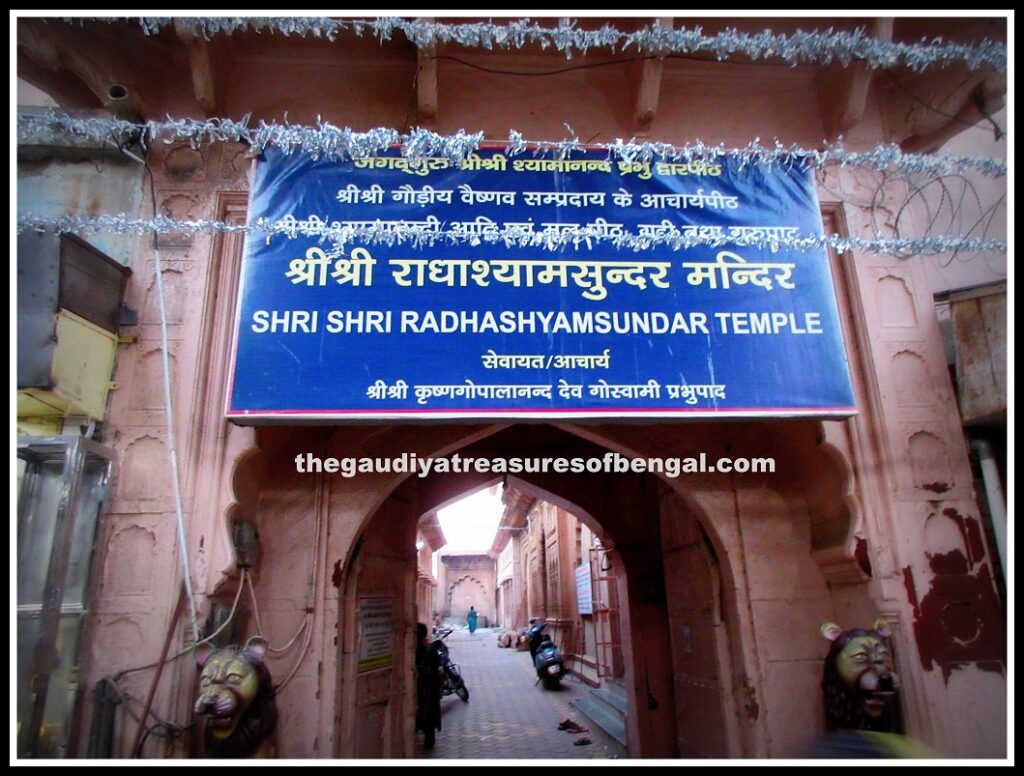
The temple has various benefits associated with worshiping Radha Shyamsundar. It is believed that those who have darshan of Sri Shyamsundar with devotion obtain Prema Bhakti, the highest form of divine love, and attain Krishna’s divine abode. Regular worshipers are said to enjoy a life filled with happiness, wealth, and opulence and go to Krishna’s abode along with ten past and ten future generations. Cleaning the temple and offering new garments, ornaments, and flower ornaments to Sri Shyamsundar also bring various spiritual and material benefits.
Overall, the Radha Shyamasundar temple in Vrindavan is a sacred place for devotees, offering them the opportunity to experience deep spiritual devotion and receive blessings and benefits through the worship of the divine couple.
Location : Mohalla Seva Kunj, near Loi Bazaar
#10 Radha Gokulananda Temple
The Radha Gokulananda Temple in Vrindavan, situated near the Kesi ghat on the banks of the Yamuna River, is a magnificent temple that unites several deities under one roof. Founded by Viswanath Cakravarti, the temple houses the deities of Radha-Vinoda, Vijaya Govinda, Radha Gokulananda, and Chaitanya Mahaprabhu. As visitors enter the temple, they are greeted by the beautifully adorned Radha-Vinoda deities. The towering figures of Vijaya Govinda exude regal elegance, while at the center, the radiant Radha Gokulananda deities stand as embodiments of divine grace and beauty.

Previously, each of these deities was worshiped in separate temples, but Viswanath Cakravarti’s vision brought them together, allowing devotees to pay their respects to all the deities in one place. The temple also features the deities of Krishna and Chaitanya Mahaprabhu, which were once worshiped by Narottama Dasa Thakur.
The temple holds historical significance, as the original deity of Radha-Vinoda is now worshiped in Jaipur for its protection during the Mughal attack on Vrindavan. The temple contains the pratibhu-murtis (replica deities) of the original deities, believed to possess the same potency. The samadhis of Lokanatha Goswami, Narottama Dasa, and Viswanath Cakravarti are located in a small courtyard adjacent to the temple.
The Radha Gokulananda Temple is a place of immense spiritual significance, where devotees can experience the divine presence and transcendental love of Lord Krishna and Radharani. The temple and its surroundings are infused with the devotion and energy of the great Vaishnava saints who resided there. To reach the temple, visitors can follow the Parikrama Marg from Kesi Ghat. The journey to the temple is filled with the vibrant atmosphere of Vrindavan, with its bustling streets, devotional music, and the fragrance of incense, creating an atmosphere of divine ecstasy.
Location : Near Kesi Ghat, Vrindavan
#11 Radha Vallabh Temple
The Radha Vallabh Temple in Vrindavan is a magnificent temple located near the famous Banke Bihari Temple. It is home to the revered deities of Sri Sri Radha Vallabha Ji, worshiped by the great saint Sri Hit Harivansh ji Maharaj. The temple courtyard can be reached by ascending a flight of stairs and navigating through a winding lane. Inside, visitors are greeted by the breathtaking darshan of Sri Sri Radha Vallabha Jiu. The deity of Radha Vallabha Ju is a “yugal jodi,” representing both Radha and Krishna in one body, with a long braid symbolizing Srimati Radharani.
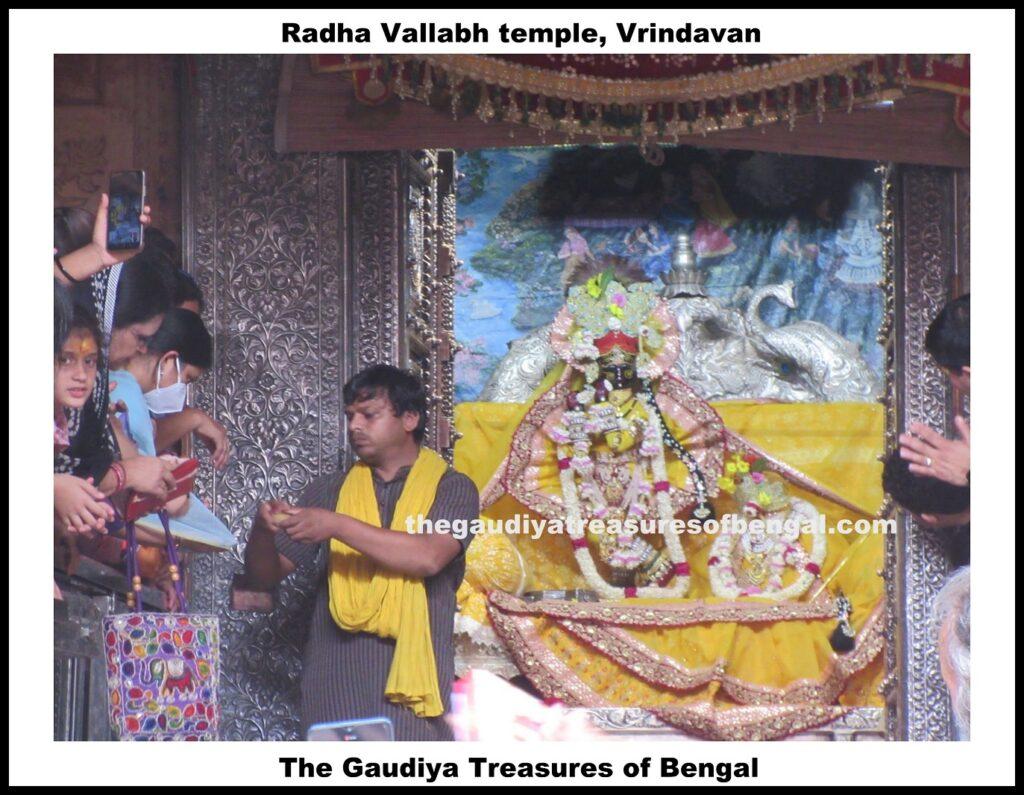
The founder of the Sri Radha Vallabh Sampradaya, Sri Hit Harivansh ji Maharaj, was born into a Gaur Brahmin family in Deoband. The temple features remarkable architecture blending Hindu and Islamic styles, with thick walls and a Triforium stage showcasing both designs. The temple remains an architectural masterpiece, emphasizing harmony, balanced massing, and constructional unity.
To reach the Radha Vallabh Temple, one must first travel to Vrindavan. The temple is conveniently located near the Banke Bihari Temple, making it easily accessible by foot from within the town. For those coming from Agra, the temple is approximately 75 kilometers away, and from Mathura Junction railway station, it is only 15 kilometers away. Taxi or local bus services can be used for transportation to the temple, allowing visitors to experience the spiritual beauty of this remarkable place.
#12 Imlitala Temple
Imli Tala Temple, located in the holy city of Vrindavan, holds immense significance and is considered one of the most revered shrines in the region. The temple, situated on Parikrama Marg, was constructed at the site where Sri Chaitanya Mahaprabhu, incarnation of Krishna, resided during his visit to Vrindavan around five hundred and fifty years ago. He would visit Imli Tala Ghat, situated on the banks of the Yamuna River, to engage in devotion and chant the holy names of Lord Hari. The temple attracts devotees from all over the world who come to offer prayers and seek blessings.

The history of Imli Tala revolves around the ancient tamarind tree that once stood there. During the rasa-lila, a divine dance of love between Radha and Krishna, Krishna vanished, leaving Radha in anguish. Meanwhile, consumed by His own feelings of separation, Krishna found solace beneath the imli tree on the banks of the Yamuna River. Lost in thought, His dark complexion gradually transformed into a radiant golden hue, mirroring the dazzling glow of His beloved Radha. According to the Vaishnavite tradition, when Krishna experiences intense separation from Radha, He undergoes a transformative change. His usual dark complexion fades away, and He takes on Radha’s brilliant, golden glow. Devotees hold this divine manifestation in the highest regard and strive to attain a similar state of devotion and surrender.
The temple houses beautiful deities, including Radha-Gopinath and Nitai-Gauranga. The walls are adorned with intricate bas-reliefs depicting the life and teachings of Chaitanya Mahaprabhu. The legacy of the grand tamarind tree is honored through a structure that protects its remnants, and a new tree symbolizes continuity and devotion.
Location : Near Kesi Ghat, Vrindavan
#13 Gopeshwar Mahadeva temple
The Gopeshwar Mahadeva Temple is located in the Banshi vat region in the town of Vrindavan. It is a magnificent shrine dedicated to Lord Shiva and is known for its unique portrayal of Lord Shiva in the form of a Gopi, a cowherd maiden of Lord Krishna. The temple’s architecture and serene surroundings create a peaceful atmosphere for spiritual contemplation. According to the temple’s history, Lord Shiva assumed the form of a Gopi to join Lord Krishna’s divine dance in Vrindavan. He was given the name “Gopeshwar ” and became the protector of the dance. The temple is adorned with beautiful decorations in the evenings and is worshiped as a Shiva linga in the mornings. It is also associated with the devotion of Srila Sanatana Goswami, who made a daily pilgrimage to the temple. To reach the Gopeshwar Mahadev Temple, one can navigate through the streets of Vrindavan, near Vamshi Vata and the Yamuna River, either by foot or by cycle rickshaw after reaching Vrindavan by road or train.

#14 Meerabai temple
The Meerabai Temple in Vrindavan is a hidden gem located near Shah Ji Temple on a peaceful street. It holds great significance as the place where the revered saint Meerabai sought solace and worshiped Lord Krishna. The temple is meticulously maintained by the descendants of the family that welcomed Meerabai in the 15th century. It exudes a powerful aura of devotion, inviting visitors to immerse themselves in its divinity and rich history. According to legend, Meerabai resided in Vrindavan for fifteen years before merging into the deity of Lord Krishna in Dwarka. The temple houses a shaligram sila, a sacred stone venerated by Meerabai, which was miraculously found by her amidst an attempt to poison her. Constructed in 1842, the temple has been lovingly cared for by the same family that once hosted Meerabai. She was a renowned saint, poetess, and devotee of Lord Krishna whose compositions express her deep love and devotion. Her writings continue to inspire people across generations, and her bhajans are widely sung and recited.
Location : Near Nidhivan
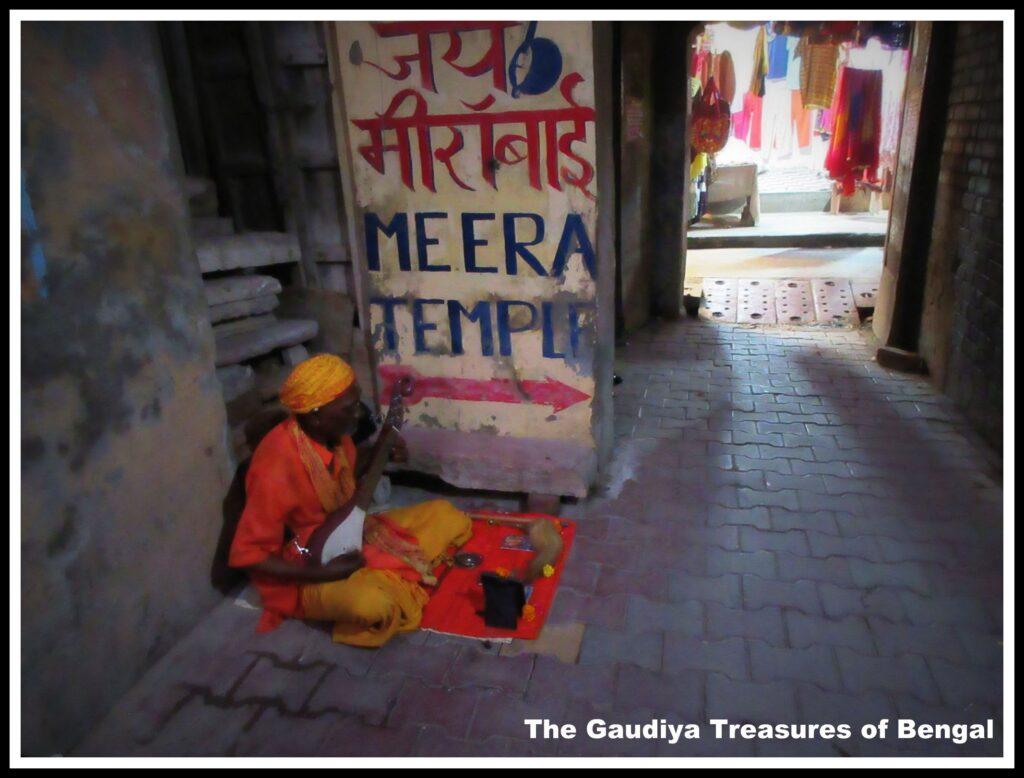
#15 Amiya Nimai Temple
The Amiya Nimai Temple is a sacred sanctuary that holds deep devotion and is dedicated to the worship of Sri Chaitanya Mahaprabhu, lovingly known as ‘Amiya Nimai’ – an embodiment of boundless love and compassion. Within the serene confines of the temple, devotees find solace as they immerse themselves in the divine atmosphere and timeless teachings of this revered spiritual luminary. Throughout its humble beginnings to its establishment as a prominent spiritual center, the Amiya Nimai Temple has been a shining beacon of love, devotion, and the enduring legacy of Sri Chaitanya Mahaprabhu.
The temple’s origin can be traced back to Sri Sarvabhauma Madhusudan Goswami, a devoted follower of Sri Chaitanya Mahaprabhu. Madhusudan Goswami acquired an ancient deity of Mahaprabhu, naming it “Sri Amiya Nimai Gauranga Mahaprabhu,” and initially installed it in Kolkata. Later, his disciple Sri Radha Govinda Goswami received the responsibility of the deity and continued its worship. Prior to his passing, he entrusted Krishna Chaitanya Goswami, his Guru’s son, with the task of shifting the deity to Vrindavan and continuing the service and worship there.

Initially, the deity was revered outside the main gate of the Radha Raman Temple. Eventually, it found a new abode near the Yamuna river within the garden of Shah Ji’s Temple. Subsequently, a dedicated temple was constructed in Gopinath Bazar, Vrindavan, where the deity of Amiya Nimai was ceremoniously installed in 1956.
Location : Gopinath Bazar, Vrindavan
#16 Shringar Vat
The word “Shringar” means to decorate, and “Vat” refers to a banyan tree. This place in Vrindavan is one of the oldest and most important temples in the area. In this sacred realm, a captivating incident unfolded, where Sri Krishna himself adorned Sri Radharani with delicate flowers. The name of this divine site, ‘Shringar Vat’, derives from the act of adorning (shringar) and the majestic banyan tree (vat) that stands as a testament to time. According to legend, Sri Krishna lovingly decorated Sri Radharani with flowers and jewels at this sacred site. The temple houses precious relics such as the original Japa beads of Sri Jiva Goswami and manuscripts by illustrious souls like Shri Rupa Goswami. Although the original banyan tree has withered, a new tree from its branch now stands tall as a reminder of the sacredness of the place. The temple celebrates the divine love of Krishna and Radharani, and nearby is the spot where Radharani sat, adorned by Krishna. The courtyard also features a temple dedicated to Radha and Krishna’s eternal love and deities of Gaura-Nitai, Lord Jagannatha, Baladeva, and Subhadra. To reach Shringar Vat, located near Kesi Ghat in Vrindavan, one can travel by road, train, or air and then head to Kesi Ghat to find the temple. Local residents and temple staff can provide directions and guidance.
Location : Near Kesi Ghat, Vrindavan
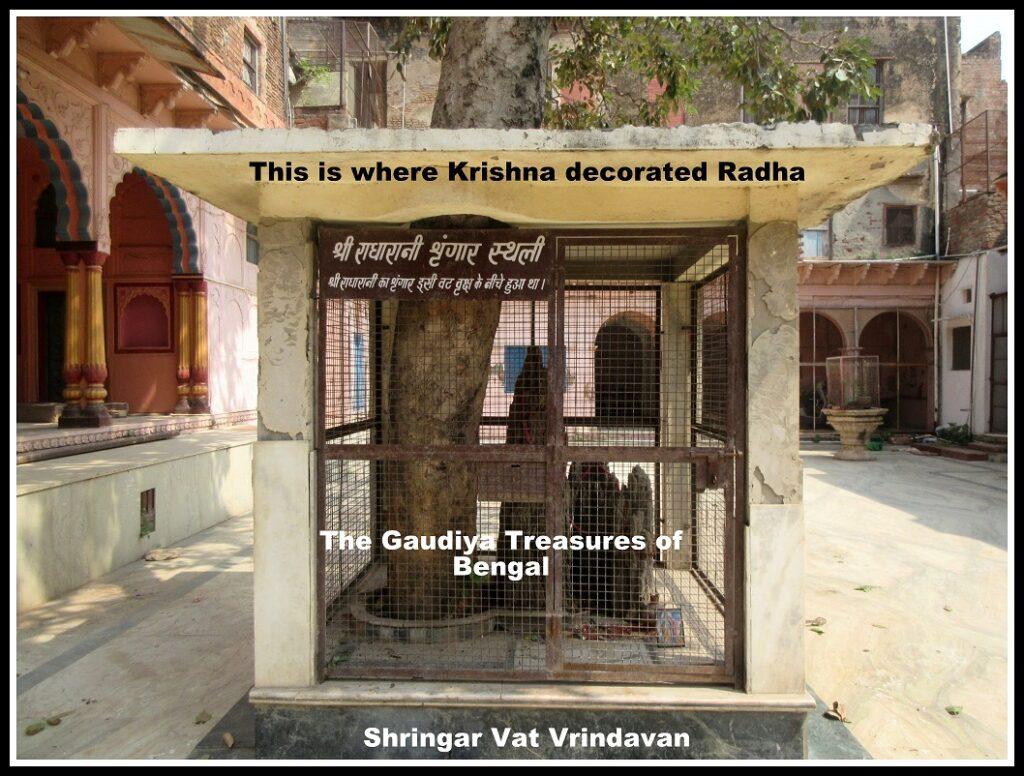
#17 Ranganatha Temple
Nestled along the enchanting Vrindavan – Mathura Marg, the resplendent Rangji Temple, also known as Sri Ranganatha Temple, stands as a testament to divine devotion. It is a sacred haven devoted to Lord Sri Goda Ranagamannar, a revered South Indian Vaishnava Saint, and Lord Ranganatha, an incarnation of Lord Krishna. Within the temple’s hallowed halls, the true gem lies in the form of an exquisite deity of Krishna, assuming the role of a bridegroom, with Goda, also known as Andal, as his cherished bride.
Andal, a luminous figure of the 8th century, emerged as a renowned Vaishnava Saint in South India, captivating hearts with her profound love for Lord Krishna. She etched her devotion into the fabric of existence through the composition of “Tiruppuvai,” an ethereal hymn that celebrated her beloved Lord Krishna and his celestial abode, Vrindavan. Legend has it that moved by her unwavering dedication, Lord Krishna graciously accepted her entreaties, consenting to become her eternal groom. This divine amalgamation of Krishna and Andal finds its ethereal manifestation within the sacred confines of the Rangji Mandir in the sacred land of Mathura-Vrindavan.
Renowned as one of the grandest temples in North India, the Rangji Temple takes its place among the revered 108 Divya Desams of the Vaishnavas. As the seasons shift and the celestial energies align, devotees from far and wide embark on a reverential pilgrimage to this spiritual haven. However, it is during the annual Sri Brahmotsav festival, held with utmost grandeur in the months of March and April, that the temple truly comes alive. During this enchanting celebration, the air pulsates with devotion as devotees flock to witness the divine union of Lord Krishna and Andal, their souls alight with the fervent ecstasy of devotion.
Location : Rangnath mandir, Goda Vihar, Vrindavan, Uttar Pradesh 281121
#18 Shahji temple
Nestled amidst the spiritual realm of Vrindavan, Shahji Temple emerges as a revered sanctuary renowned for its captivating architecture. Its unique design, characterized by enchanting spiral columns, has bestowed upon it the endearing epithet of “Tedhe Khambe Wala Mandir” – the temple with spiral columns. Every corner of this divine abode exudes an aura of mystique and devotion.
One of the temple’s notable features is the resplendent Basanti Kamra hall, an exquisite chamber adorned with ornate embellishments. Within its hallowed walls, Belgian glass chandeliers hang in all their grandeur, casting a mesmerizing glow that illuminates the hall. As one gazes upon the surroundings, they are greeted by vivid paintings that vividly depict enchanting narratives from the wondrous life of Lord Krishna. These captivating artworks serve as windows into the divine pastimes of the supreme deity.
At the heart of the Shahji Temple, reigning over the souls of devotees, stands the presiding deity – Radha-Krishna. In the realm of devotion, they are affectionately known as Chhote Radha-Raman, a title that evokes the intimacy and profound connection shared between the divine couple. It is within the enchanting embrace of this sacred abode that devotees immerse themselves in the divine presence, basking in the eternal love and eternal bliss emanating from the divine forms of Radha-Krishna.
Location : Gotam Nagar, Vrindavan, Uttar Pradesh, 281121, India
#19 Sonar Gauranga Temple
Nestled near Vrindavan’s enchanting Radha Gopinath Temple, the ancient and revered Sonar Gauranga Temple stands as a testament to divine beauty and devotion. Within its sacred walls, exquisite brass deities of Lord Chaitanya and Lord Nityananda emanate a resplendent golden glow, captivating the hearts of devotees who come from far and wide. Sonar Gauranga, meaning the ‘Golden Gauranga’, reflects the ethereal brilliance that adorns these sacred forms. Though crafted from sturdy brass, their luminous visages exude a divine aura, reminiscent of molten gold, evoking a sense of majestic divinity. These cherished deities were once worshiped by the venerable Jagannath das Babaji, who resided in the nearby Surya Kunda. The temple also houses various objects used by the revered saint, adding to its mystique. With its ethereal charm and celestial radiance, the Sonar Gauranga Temple invites seekers to immerse themselves in the transcendental aura of Lord Chaitanya and Lord Nityananda, forever etching their divine presence within the hearts of devoted souls.
Location : Near Radha Gopinath temple Vrindavan

#20 Vrindavan Chandrodaya Mandir
Vrindavan Chandrodaya Mandir in Vrindavan is a sacred and significant holy site for devotees worldwide. The project, initiated by ISKCON Bangalore, aims to create a majestic temple dedicated to Lord Sri Krishna. Surrounded by a lush park filled with green pastures, fruit-bearing trees, and serene water bodies, the temple will transport visitors to the enchanting times of Krishna.
The temple complex will feature attractions such as boat rides and displays of Krishna’s divine pastimes, presented through dolls in natural surroundings with captivating sound and light effects. The highlight of the project is its grandeur, as it aspires to become the world’s tallest temple of Krishna.
In addition to providing a spiritual experience, Vrindavan Chandrodaya Mandir will offer comfortable accommodation facilities for tourists, creating a home away from home. Visitors can immerse themselves in Krishna Bhakti and relish the essence of Vrindavan, known as the land of eternal spring. The project also includes permanent housing for devotees who wish to make Vrindavan their home.
With its dedication to preserving Vedic values and shaping the future of the country’s youth, the temple-cum-heritage project holds immense significance. The South wing of the Vrindavan Chandrodaya Mandir is set to be inaugurated during the auspicious month of Kartik in 2023, marking a milestone in this grand endeavor.
Location : Bhaktivedanta Swami Marg, Vrindavan
#21 Sixty-Four (64) Samadhis
The 64 Samadhis Temple in Vrindavan, located near the Radha Govinda Temple, is a garden that holds the name (nama) and flower (pushpa) samadhis of 64 significant Gaudiya Vaishnava Acharyas, who were closely associated with Sri Chaitanya Mahaprabhu. These revered devotees are regarded by Vaishnava authorities as Lord Chaitanya’s most confidential associates.

The establishment of the samadhis began with Raghunath Bhatta Goswami, Kasisvara Pandit Goswami, and Subuddhi Raya. Over time, approximately 150 years ago, the managers of the Govindaji temple began adding more samadhis, including pushpa, smriti, or nama samadhis. The majority of the samadhis are nama samadhis, where the names of these Vaishnava personalities are inscribed.
The 64 Samadhis Temple serves as a sacred space to honor and remember these esteemed Vaishnava Acharyas, embodying their contributions and devotion to the Gaudiya Vaishnava tradition.